Massed vs. Distributed Practice: PSY10004 Research Report Analysis
VerifiedAdded on 2022/12/01
|11
|2761
|148
Report
AI Summary
This psychology research report investigates the effectiveness of massed versus distributed practice on learning and memory retention. The study, conducted with 239 psychology students, examined how different study strategies (massed vs. distributed) influenced performance on fill-in-the-blank and multiple-choice tests. Participants were assigned to either massed practice (6 hours in one sitting) or distributed practice (2 hours a day for three days) and tested three weeks later. The results indicated that distributed practice led to better performance on fill-in-the-blank questions and overall scores, while massed practice showed better results on multiple-choice questions. The report includes a detailed methodology, statistical analysis, and discussion of the findings, providing valuable insights into the optimal study strategies for different types of assessments. The report concludes with recommendations on how spacing might be assimilated to the daily instruction.
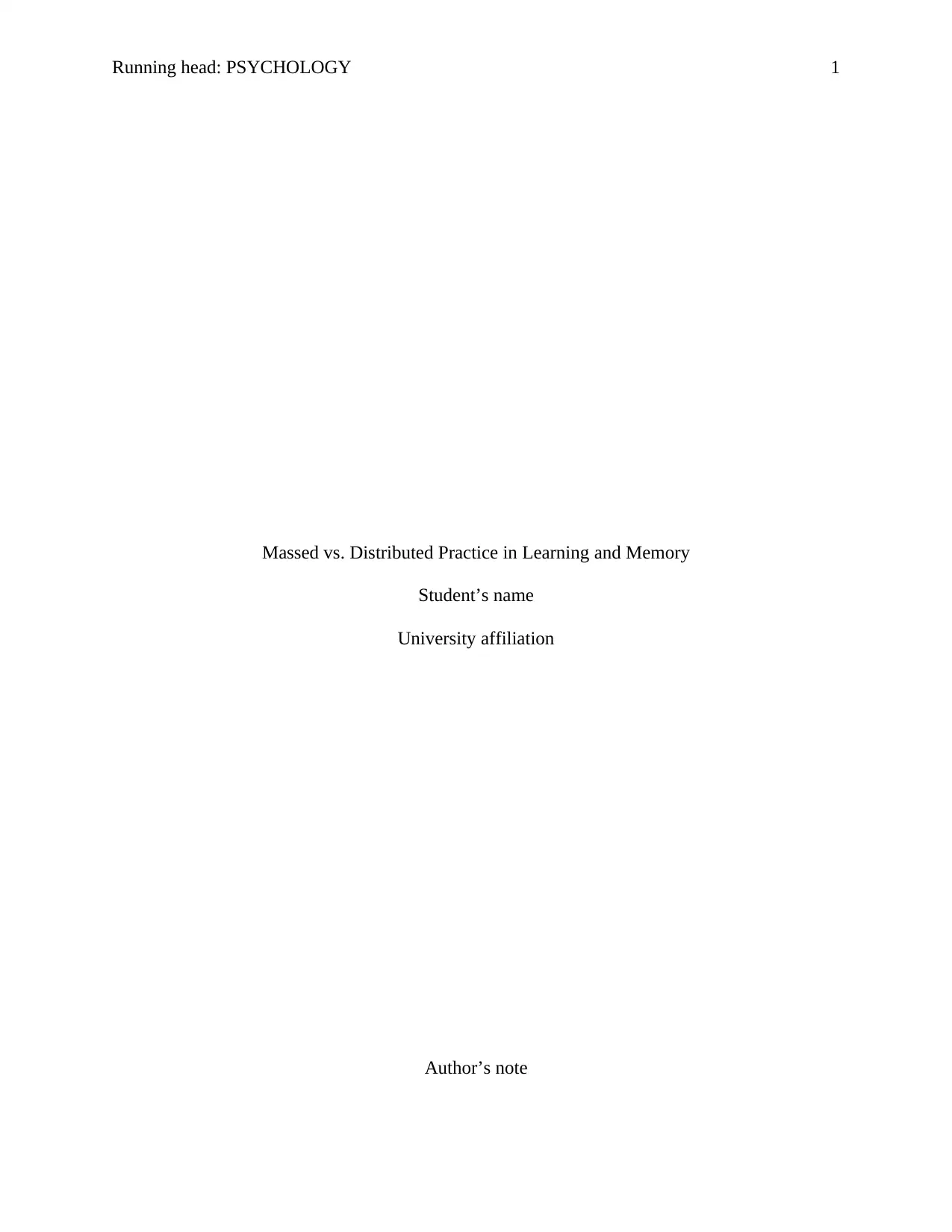
Running head: PSYCHOLOGY 1
Massed vs. Distributed Practice in Learning and Memory
Student’s name
University affiliation
Author’s note
Massed vs. Distributed Practice in Learning and Memory
Student’s name
University affiliation
Author’s note
Paraphrase This Document
Need a fresh take? Get an instant paraphrase of this document with our AI Paraphraser
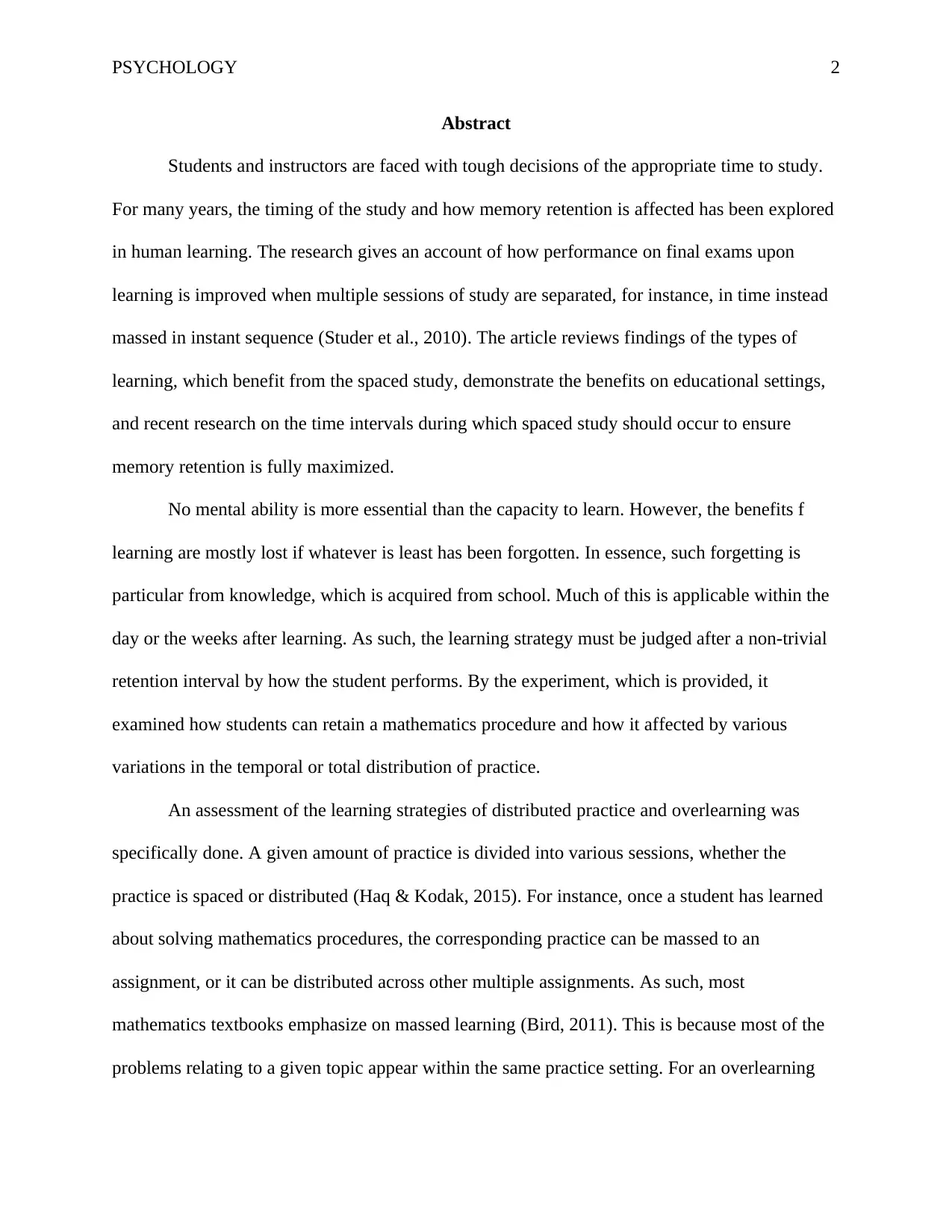
PSYCHOLOGY 2
Abstract
Students and instructors are faced with tough decisions of the appropriate time to study.
For many years, the timing of the study and how memory retention is affected has been explored
in human learning. The research gives an account of how performance on final exams upon
learning is improved when multiple sessions of study are separated, for instance, in time instead
massed in instant sequence (Studer et al., 2010). The article reviews findings of the types of
learning, which benefit from the spaced study, demonstrate the benefits on educational settings,
and recent research on the time intervals during which spaced study should occur to ensure
memory retention is fully maximized.
No mental ability is more essential than the capacity to learn. However, the benefits f
learning are mostly lost if whatever is least has been forgotten. In essence, such forgetting is
particular from knowledge, which is acquired from school. Much of this is applicable within the
day or the weeks after learning. As such, the learning strategy must be judged after a non-trivial
retention interval by how the student performs. By the experiment, which is provided, it
examined how students can retain a mathematics procedure and how it affected by various
variations in the temporal or total distribution of practice.
An assessment of the learning strategies of distributed practice and overlearning was
specifically done. A given amount of practice is divided into various sessions, whether the
practice is spaced or distributed (Haq & Kodak, 2015). For instance, once a student has learned
about solving mathematics procedures, the corresponding practice can be massed to an
assignment, or it can be distributed across other multiple assignments. As such, most
mathematics textbooks emphasize on massed learning (Bird, 2011). This is because most of the
problems relating to a given topic appear within the same practice setting. For an overlearning
Abstract
Students and instructors are faced with tough decisions of the appropriate time to study.
For many years, the timing of the study and how memory retention is affected has been explored
in human learning. The research gives an account of how performance on final exams upon
learning is improved when multiple sessions of study are separated, for instance, in time instead
massed in instant sequence (Studer et al., 2010). The article reviews findings of the types of
learning, which benefit from the spaced study, demonstrate the benefits on educational settings,
and recent research on the time intervals during which spaced study should occur to ensure
memory retention is fully maximized.
No mental ability is more essential than the capacity to learn. However, the benefits f
learning are mostly lost if whatever is least has been forgotten. In essence, such forgetting is
particular from knowledge, which is acquired from school. Much of this is applicable within the
day or the weeks after learning. As such, the learning strategy must be judged after a non-trivial
retention interval by how the student performs. By the experiment, which is provided, it
examined how students can retain a mathematics procedure and how it affected by various
variations in the temporal or total distribution of practice.
An assessment of the learning strategies of distributed practice and overlearning was
specifically done. A given amount of practice is divided into various sessions, whether the
practice is spaced or distributed (Haq & Kodak, 2015). For instance, once a student has learned
about solving mathematics procedures, the corresponding practice can be massed to an
assignment, or it can be distributed across other multiple assignments. As such, most
mathematics textbooks emphasize on massed learning (Bird, 2011). This is because most of the
problems relating to a given topic appear within the same practice setting. For an overlearning
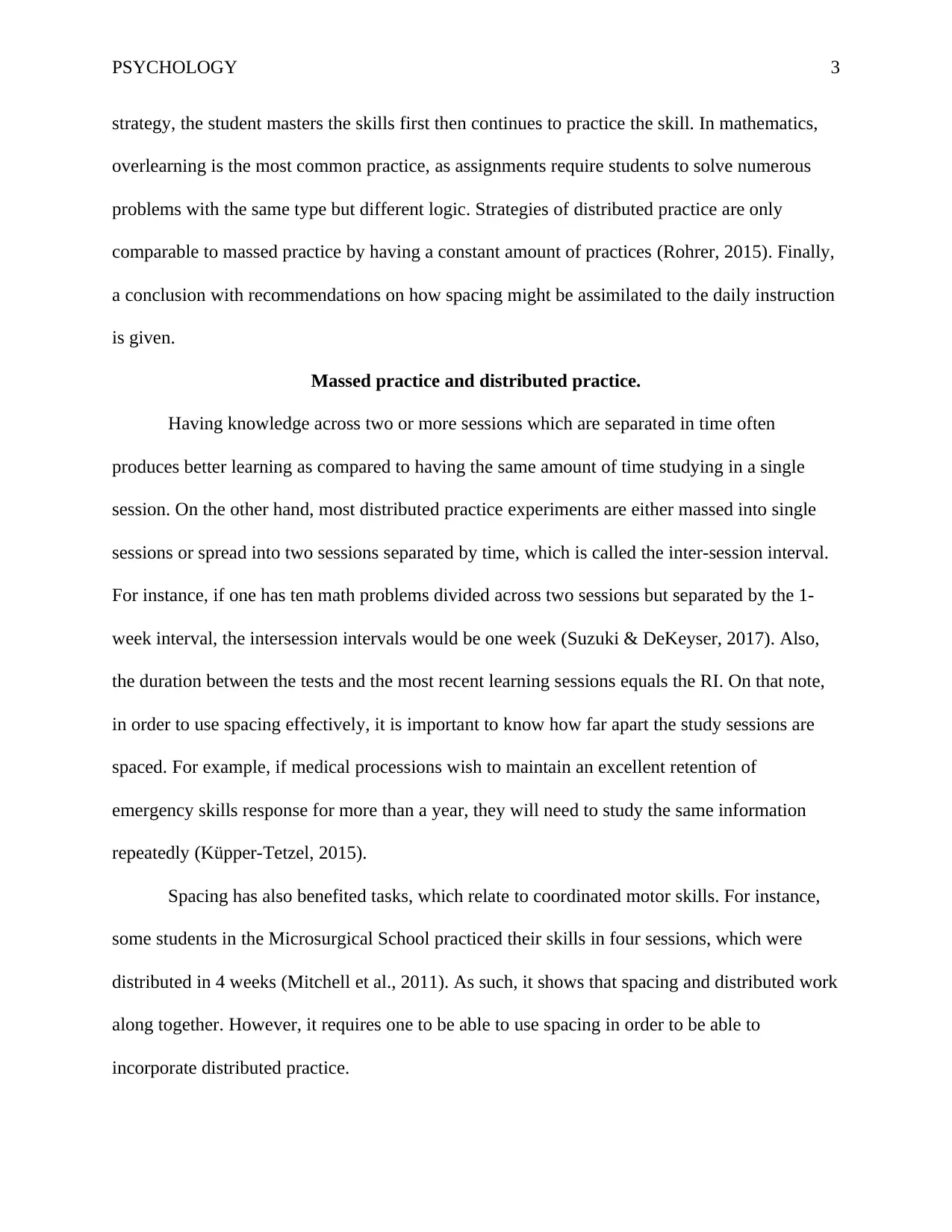
PSYCHOLOGY 3
strategy, the student masters the skills first then continues to practice the skill. In mathematics,
overlearning is the most common practice, as assignments require students to solve numerous
problems with the same type but different logic. Strategies of distributed practice are only
comparable to massed practice by having a constant amount of practices (Rohrer, 2015). Finally,
a conclusion with recommendations on how spacing might be assimilated to the daily instruction
is given.
Massed practice and distributed practice.
Having knowledge across two or more sessions which are separated in time often
produces better learning as compared to having the same amount of time studying in a single
session. On the other hand, most distributed practice experiments are either massed into single
sessions or spread into two sessions separated by time, which is called the inter-session interval.
For instance, if one has ten math problems divided across two sessions but separated by the 1-
week interval, the intersession intervals would be one week (Suzuki & DeKeyser, 2017). Also,
the duration between the tests and the most recent learning sessions equals the RI. On that note,
in order to use spacing effectively, it is important to know how far apart the study sessions are
spaced. For example, if medical processions wish to maintain an excellent retention of
emergency skills response for more than a year, they will need to study the same information
repeatedly (Küpper-Tetzel, 2015).
Spacing has also benefited tasks, which relate to coordinated motor skills. For instance,
some students in the Microsurgical School practiced their skills in four sessions, which were
distributed in 4 weeks (Mitchell et al., 2011). As such, it shows that spacing and distributed work
along together. However, it requires one to be able to use spacing in order to be able to
incorporate distributed practice.
strategy, the student masters the skills first then continues to practice the skill. In mathematics,
overlearning is the most common practice, as assignments require students to solve numerous
problems with the same type but different logic. Strategies of distributed practice are only
comparable to massed practice by having a constant amount of practices (Rohrer, 2015). Finally,
a conclusion with recommendations on how spacing might be assimilated to the daily instruction
is given.
Massed practice and distributed practice.
Having knowledge across two or more sessions which are separated in time often
produces better learning as compared to having the same amount of time studying in a single
session. On the other hand, most distributed practice experiments are either massed into single
sessions or spread into two sessions separated by time, which is called the inter-session interval.
For instance, if one has ten math problems divided across two sessions but separated by the 1-
week interval, the intersession intervals would be one week (Suzuki & DeKeyser, 2017). Also,
the duration between the tests and the most recent learning sessions equals the RI. On that note,
in order to use spacing effectively, it is important to know how far apart the study sessions are
spaced. For example, if medical processions wish to maintain an excellent retention of
emergency skills response for more than a year, they will need to study the same information
repeatedly (Küpper-Tetzel, 2015).
Spacing has also benefited tasks, which relate to coordinated motor skills. For instance,
some students in the Microsurgical School practiced their skills in four sessions, which were
distributed in 4 weeks (Mitchell et al., 2011). As such, it shows that spacing and distributed work
along together. However, it requires one to be able to use spacing in order to be able to
incorporate distributed practice.
⊘ This is a preview!⊘
Do you want full access?
Subscribe today to unlock all pages.

Trusted by 1+ million students worldwide
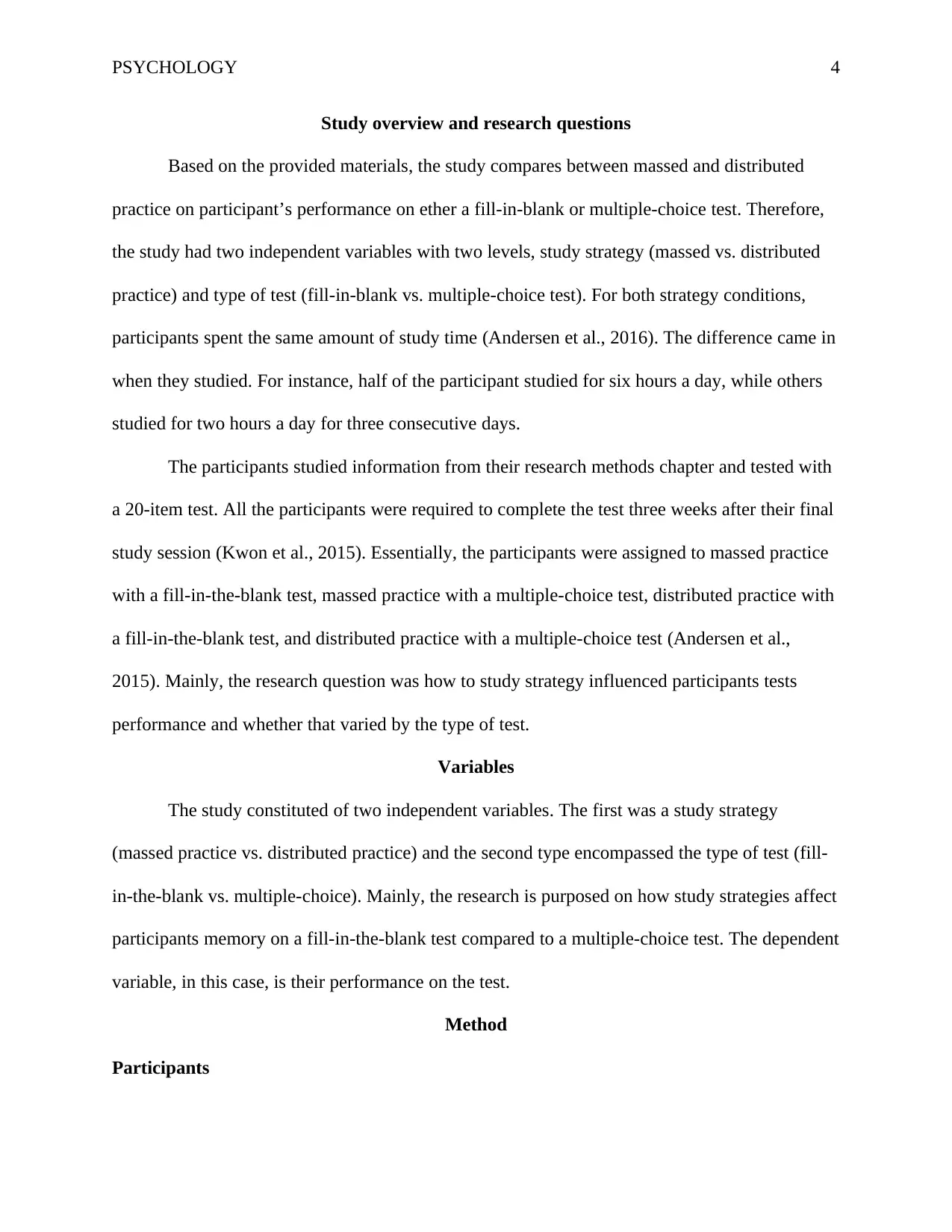
PSYCHOLOGY 4
Study overview and research questions
Based on the provided materials, the study compares between massed and distributed
practice on participant’s performance on ether a fill-in-blank or multiple-choice test. Therefore,
the study had two independent variables with two levels, study strategy (massed vs. distributed
practice) and type of test (fill-in-blank vs. multiple-choice test). For both strategy conditions,
participants spent the same amount of study time (Andersen et al., 2016). The difference came in
when they studied. For instance, half of the participant studied for six hours a day, while others
studied for two hours a day for three consecutive days.
The participants studied information from their research methods chapter and tested with
a 20-item test. All the participants were required to complete the test three weeks after their final
study session (Kwon et al., 2015). Essentially, the participants were assigned to massed practice
with a fill-in-the-blank test, massed practice with a multiple-choice test, distributed practice with
a fill-in-the-blank test, and distributed practice with a multiple-choice test (Andersen et al.,
2015). Mainly, the research question was how to study strategy influenced participants tests
performance and whether that varied by the type of test.
Variables
The study constituted of two independent variables. The first was a study strategy
(massed practice vs. distributed practice) and the second type encompassed the type of test (fill-
in-the-blank vs. multiple-choice). Mainly, the research is purposed on how study strategies affect
participants memory on a fill-in-the-blank test compared to a multiple-choice test. The dependent
variable, in this case, is their performance on the test.
Method
Participants
Study overview and research questions
Based on the provided materials, the study compares between massed and distributed
practice on participant’s performance on ether a fill-in-blank or multiple-choice test. Therefore,
the study had two independent variables with two levels, study strategy (massed vs. distributed
practice) and type of test (fill-in-blank vs. multiple-choice test). For both strategy conditions,
participants spent the same amount of study time (Andersen et al., 2016). The difference came in
when they studied. For instance, half of the participant studied for six hours a day, while others
studied for two hours a day for three consecutive days.
The participants studied information from their research methods chapter and tested with
a 20-item test. All the participants were required to complete the test three weeks after their final
study session (Kwon et al., 2015). Essentially, the participants were assigned to massed practice
with a fill-in-the-blank test, massed practice with a multiple-choice test, distributed practice with
a fill-in-the-blank test, and distributed practice with a multiple-choice test (Andersen et al.,
2015). Mainly, the research question was how to study strategy influenced participants tests
performance and whether that varied by the type of test.
Variables
The study constituted of two independent variables. The first was a study strategy
(massed practice vs. distributed practice) and the second type encompassed the type of test (fill-
in-the-blank vs. multiple-choice). Mainly, the research is purposed on how study strategies affect
participants memory on a fill-in-the-blank test compared to a multiple-choice test. The dependent
variable, in this case, is their performance on the test.
Method
Participants
Paraphrase This Document
Need a fresh take? Get an instant paraphrase of this document with our AI Paraphraser
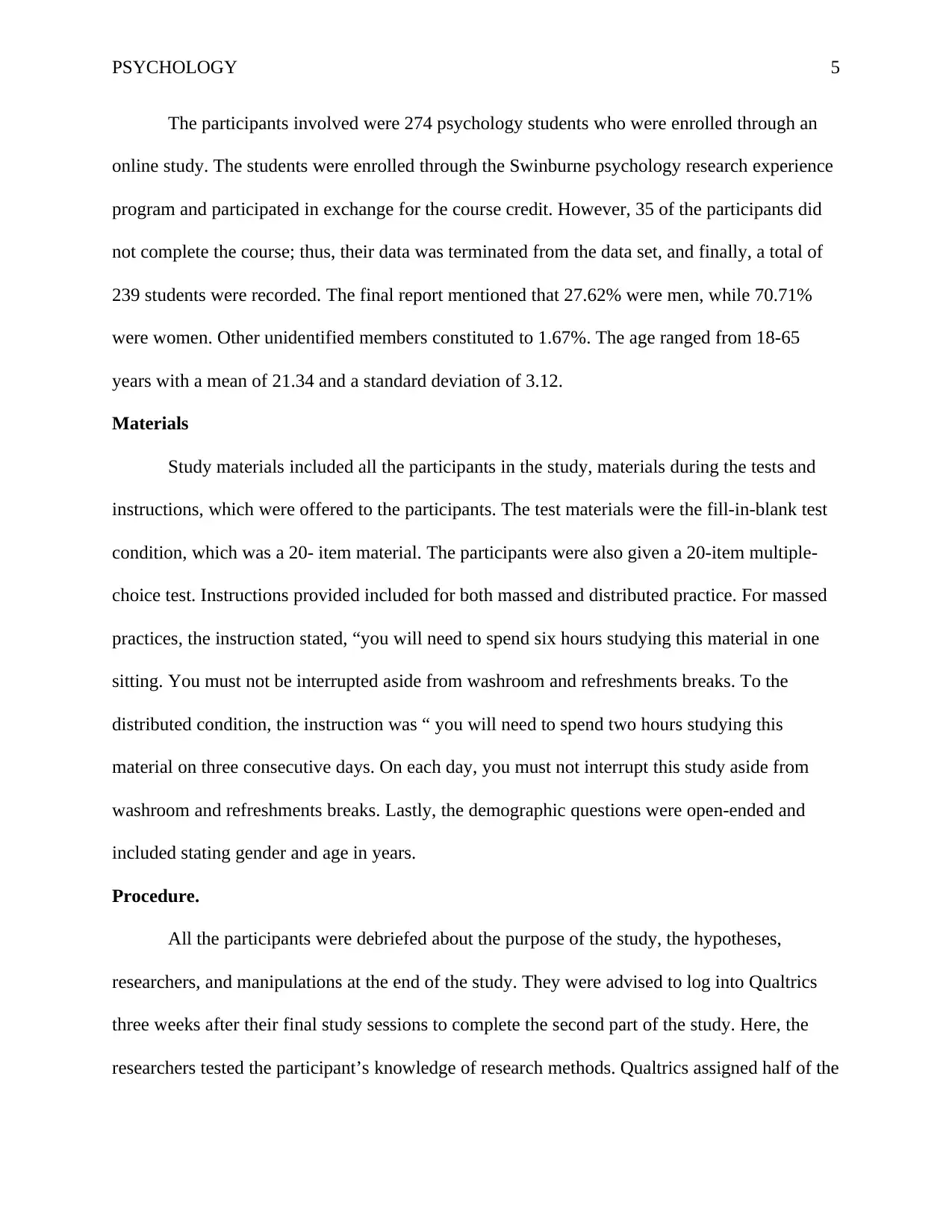
PSYCHOLOGY 5
The participants involved were 274 psychology students who were enrolled through an
online study. The students were enrolled through the Swinburne psychology research experience
program and participated in exchange for the course credit. However, 35 of the participants did
not complete the course; thus, their data was terminated from the data set, and finally, a total of
239 students were recorded. The final report mentioned that 27.62% were men, while 70.71%
were women. Other unidentified members constituted to 1.67%. The age ranged from 18-65
years with a mean of 21.34 and a standard deviation of 3.12.
Materials
Study materials included all the participants in the study, materials during the tests and
instructions, which were offered to the participants. The test materials were the fill-in-blank test
condition, which was a 20- item material. The participants were also given a 20-item multiple-
choice test. Instructions provided included for both massed and distributed practice. For massed
practices, the instruction stated, “you will need to spend six hours studying this material in one
sitting. You must not be interrupted aside from washroom and refreshments breaks. To the
distributed condition, the instruction was “ you will need to spend two hours studying this
material on three consecutive days. On each day, you must not interrupt this study aside from
washroom and refreshments breaks. Lastly, the demographic questions were open-ended and
included stating gender and age in years.
Procedure.
All the participants were debriefed about the purpose of the study, the hypotheses,
researchers, and manipulations at the end of the study. They were advised to log into Qualtrics
three weeks after their final study sessions to complete the second part of the study. Here, the
researchers tested the participant’s knowledge of research methods. Qualtrics assigned half of the
The participants involved were 274 psychology students who were enrolled through an
online study. The students were enrolled through the Swinburne psychology research experience
program and participated in exchange for the course credit. However, 35 of the participants did
not complete the course; thus, their data was terminated from the data set, and finally, a total of
239 students were recorded. The final report mentioned that 27.62% were men, while 70.71%
were women. Other unidentified members constituted to 1.67%. The age ranged from 18-65
years with a mean of 21.34 and a standard deviation of 3.12.
Materials
Study materials included all the participants in the study, materials during the tests and
instructions, which were offered to the participants. The test materials were the fill-in-blank test
condition, which was a 20- item material. The participants were also given a 20-item multiple-
choice test. Instructions provided included for both massed and distributed practice. For massed
practices, the instruction stated, “you will need to spend six hours studying this material in one
sitting. You must not be interrupted aside from washroom and refreshments breaks. To the
distributed condition, the instruction was “ you will need to spend two hours studying this
material on three consecutive days. On each day, you must not interrupt this study aside from
washroom and refreshments breaks. Lastly, the demographic questions were open-ended and
included stating gender and age in years.
Procedure.
All the participants were debriefed about the purpose of the study, the hypotheses,
researchers, and manipulations at the end of the study. They were advised to log into Qualtrics
three weeks after their final study sessions to complete the second part of the study. Here, the
researchers tested the participant’s knowledge of research methods. Qualtrics assigned half of the
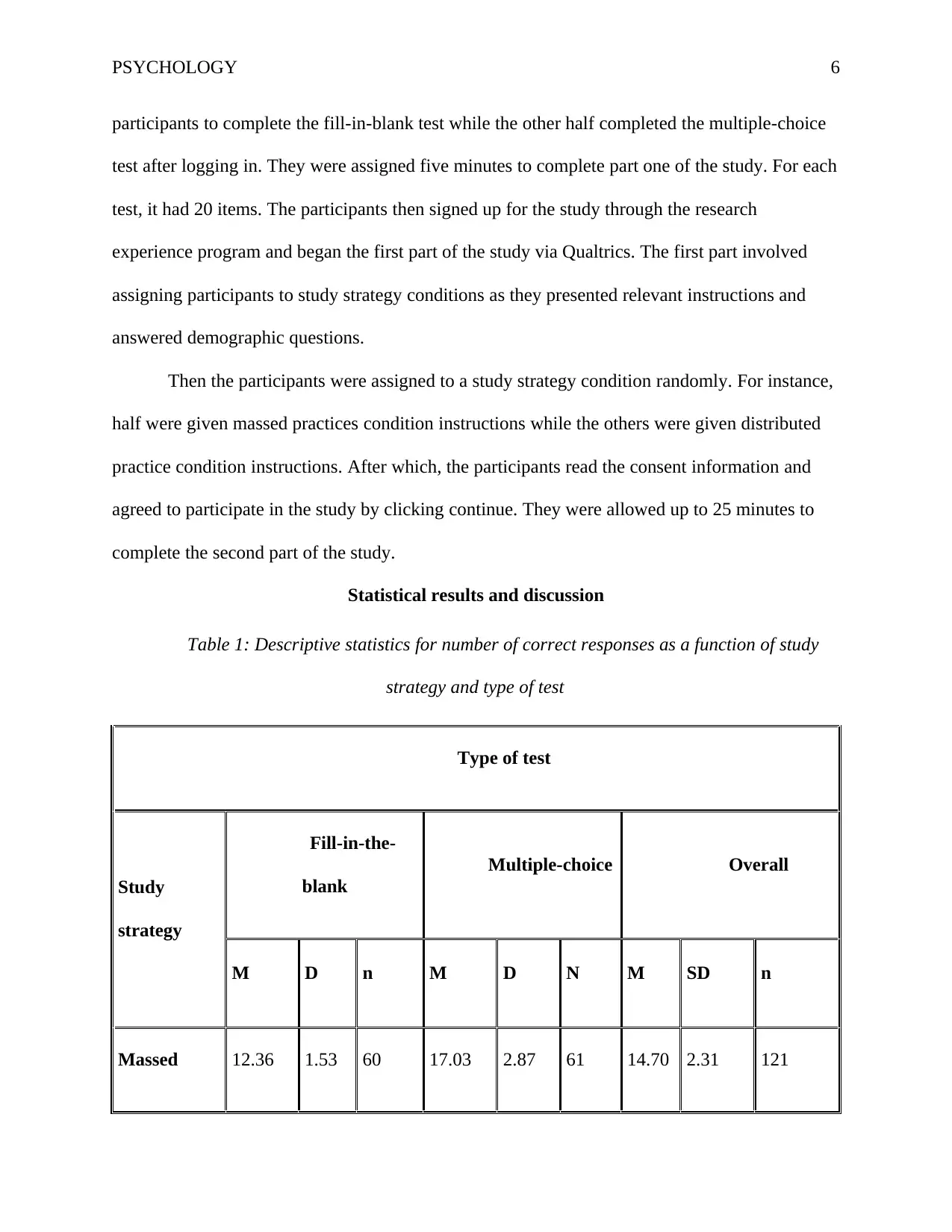
PSYCHOLOGY 6
participants to complete the fill-in-blank test while the other half completed the multiple-choice
test after logging in. They were assigned five minutes to complete part one of the study. For each
test, it had 20 items. The participants then signed up for the study through the research
experience program and began the first part of the study via Qualtrics. The first part involved
assigning participants to study strategy conditions as they presented relevant instructions and
answered demographic questions.
Then the participants were assigned to a study strategy condition randomly. For instance,
half were given massed practices condition instructions while the others were given distributed
practice condition instructions. After which, the participants read the consent information and
agreed to participate in the study by clicking continue. They were allowed up to 25 minutes to
complete the second part of the study.
Statistical results and discussion
Table 1: Descriptive statistics for number of correct responses as a function of study
strategy and type of test
Type of test
Study
strategy
Fill-in-the-
blank
Multiple-choice Overall
M D n M D N M SD n
Massed 12.36 1.53 60 17.03 2.87 61 14.70 2.31 121
participants to complete the fill-in-blank test while the other half completed the multiple-choice
test after logging in. They were assigned five minutes to complete part one of the study. For each
test, it had 20 items. The participants then signed up for the study through the research
experience program and began the first part of the study via Qualtrics. The first part involved
assigning participants to study strategy conditions as they presented relevant instructions and
answered demographic questions.
Then the participants were assigned to a study strategy condition randomly. For instance,
half were given massed practices condition instructions while the others were given distributed
practice condition instructions. After which, the participants read the consent information and
agreed to participate in the study by clicking continue. They were allowed up to 25 minutes to
complete the second part of the study.
Statistical results and discussion
Table 1: Descriptive statistics for number of correct responses as a function of study
strategy and type of test
Type of test
Study
strategy
Fill-in-the-
blank
Multiple-choice Overall
M D n M D N M SD n
Massed 12.36 1.53 60 17.03 2.87 61 14.70 2.31 121
⊘ This is a preview!⊘
Do you want full access?
Subscribe today to unlock all pages.

Trusted by 1+ million students worldwide
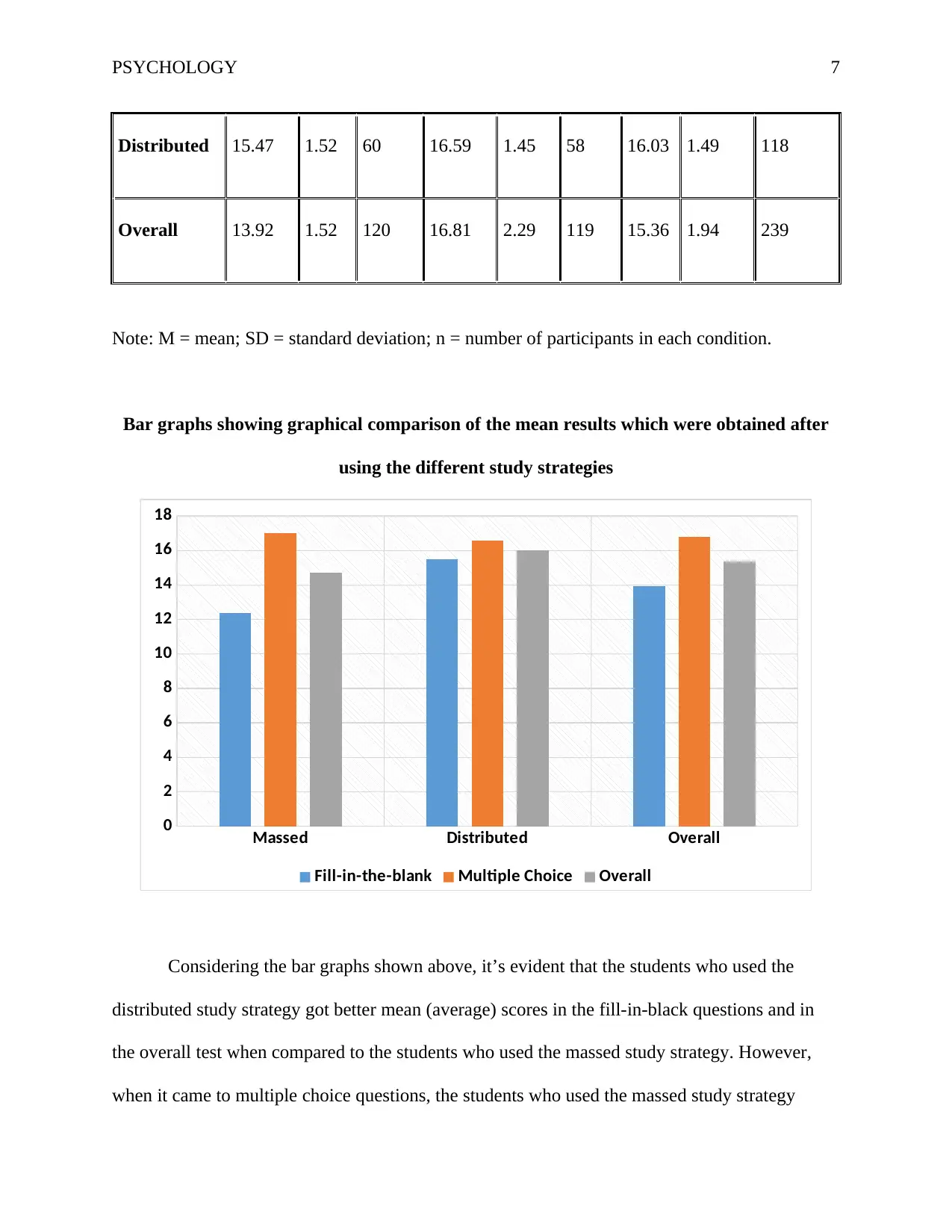
PSYCHOLOGY 7
Distributed 15.47 1.52 60 16.59 1.45 58 16.03 1.49 118
Overall 13.92 1.52 120 16.81 2.29 119 15.36 1.94 239
Note: M = mean; SD = standard deviation; n = number of participants in each condition.
Bar graphs showing graphical comparison of the mean results which were obtained after
using the different study strategies
Massed Distributed Overall
0
2
4
6
8
10
12
14
16
18
Fill-in-the-blank Multiple Choice Overall
Considering the bar graphs shown above, it’s evident that the students who used the
distributed study strategy got better mean (average) scores in the fill-in-black questions and in
the overall test when compared to the students who used the massed study strategy. However,
when it came to multiple choice questions, the students who used the massed study strategy
Distributed 15.47 1.52 60 16.59 1.45 58 16.03 1.49 118
Overall 13.92 1.52 120 16.81 2.29 119 15.36 1.94 239
Note: M = mean; SD = standard deviation; n = number of participants in each condition.
Bar graphs showing graphical comparison of the mean results which were obtained after
using the different study strategies
Massed Distributed Overall
0
2
4
6
8
10
12
14
16
18
Fill-in-the-blank Multiple Choice Overall
Considering the bar graphs shown above, it’s evident that the students who used the
distributed study strategy got better mean (average) scores in the fill-in-black questions and in
the overall test when compared to the students who used the massed study strategy. However,
when it came to multiple choice questions, the students who used the massed study strategy
Paraphrase This Document
Need a fresh take? Get an instant paraphrase of this document with our AI Paraphraser
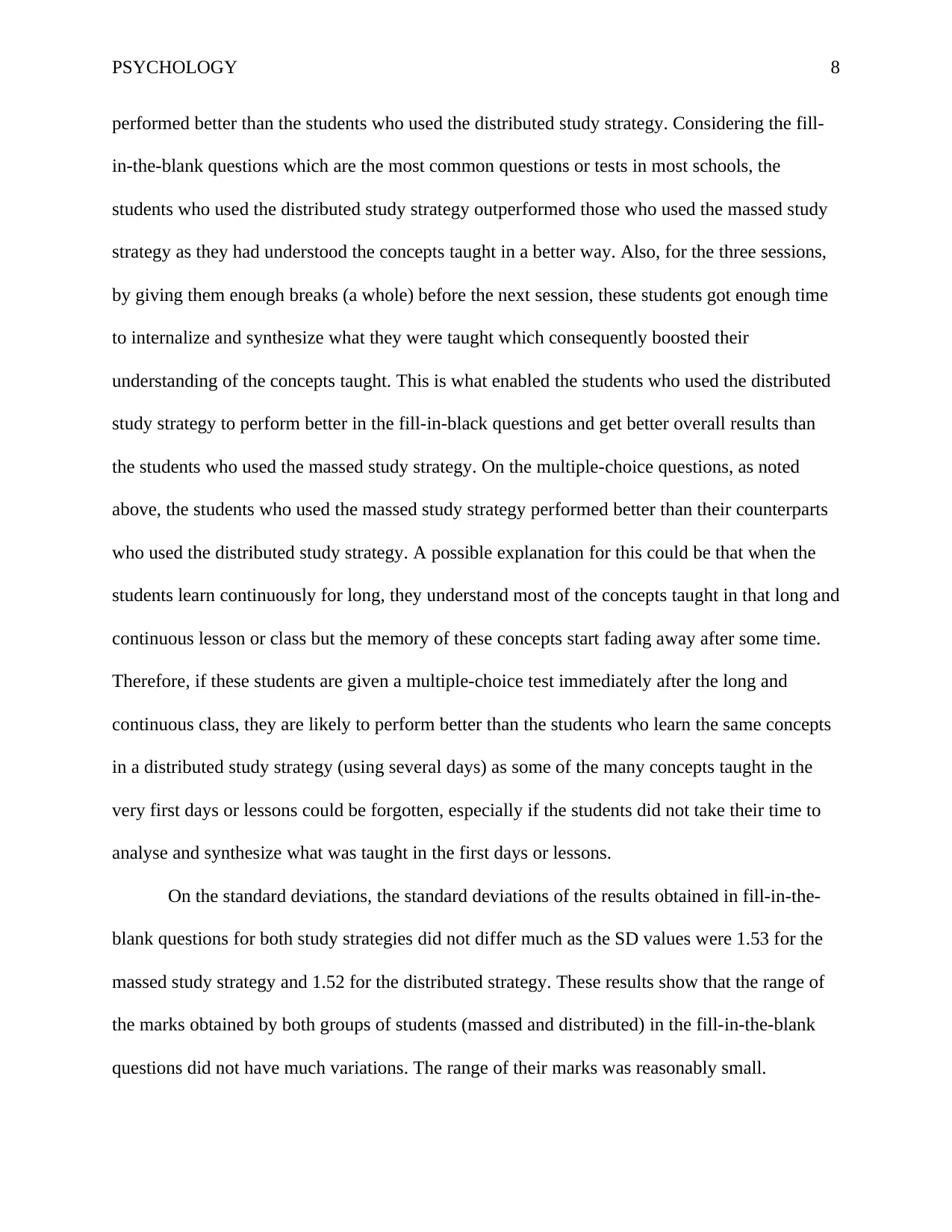
PSYCHOLOGY 8
performed better than the students who used the distributed study strategy. Considering the fill-
in-the-blank questions which are the most common questions or tests in most schools, the
students who used the distributed study strategy outperformed those who used the massed study
strategy as they had understood the concepts taught in a better way. Also, for the three sessions,
by giving them enough breaks (a whole) before the next session, these students got enough time
to internalize and synthesize what they were taught which consequently boosted their
understanding of the concepts taught. This is what enabled the students who used the distributed
study strategy to perform better in the fill-in-black questions and get better overall results than
the students who used the massed study strategy. On the multiple-choice questions, as noted
above, the students who used the massed study strategy performed better than their counterparts
who used the distributed study strategy. A possible explanation for this could be that when the
students learn continuously for long, they understand most of the concepts taught in that long and
continuous lesson or class but the memory of these concepts start fading away after some time.
Therefore, if these students are given a multiple-choice test immediately after the long and
continuous class, they are likely to perform better than the students who learn the same concepts
in a distributed study strategy (using several days) as some of the many concepts taught in the
very first days or lessons could be forgotten, especially if the students did not take their time to
analyse and synthesize what was taught in the first days or lessons.
On the standard deviations, the standard deviations of the results obtained in fill-in-the-
blank questions for both study strategies did not differ much as the SD values were 1.53 for the
massed study strategy and 1.52 for the distributed strategy. These results show that the range of
the marks obtained by both groups of students (massed and distributed) in the fill-in-the-blank
questions did not have much variations. The range of their marks was reasonably small.
performed better than the students who used the distributed study strategy. Considering the fill-
in-the-blank questions which are the most common questions or tests in most schools, the
students who used the distributed study strategy outperformed those who used the massed study
strategy as they had understood the concepts taught in a better way. Also, for the three sessions,
by giving them enough breaks (a whole) before the next session, these students got enough time
to internalize and synthesize what they were taught which consequently boosted their
understanding of the concepts taught. This is what enabled the students who used the distributed
study strategy to perform better in the fill-in-black questions and get better overall results than
the students who used the massed study strategy. On the multiple-choice questions, as noted
above, the students who used the massed study strategy performed better than their counterparts
who used the distributed study strategy. A possible explanation for this could be that when the
students learn continuously for long, they understand most of the concepts taught in that long and
continuous lesson or class but the memory of these concepts start fading away after some time.
Therefore, if these students are given a multiple-choice test immediately after the long and
continuous class, they are likely to perform better than the students who learn the same concepts
in a distributed study strategy (using several days) as some of the many concepts taught in the
very first days or lessons could be forgotten, especially if the students did not take their time to
analyse and synthesize what was taught in the first days or lessons.
On the standard deviations, the standard deviations of the results obtained in fill-in-the-
blank questions for both study strategies did not differ much as the SD values were 1.53 for the
massed study strategy and 1.52 for the distributed strategy. These results show that the range of
the marks obtained by both groups of students (massed and distributed) in the fill-in-the-blank
questions did not have much variations. The range of their marks was reasonably small.
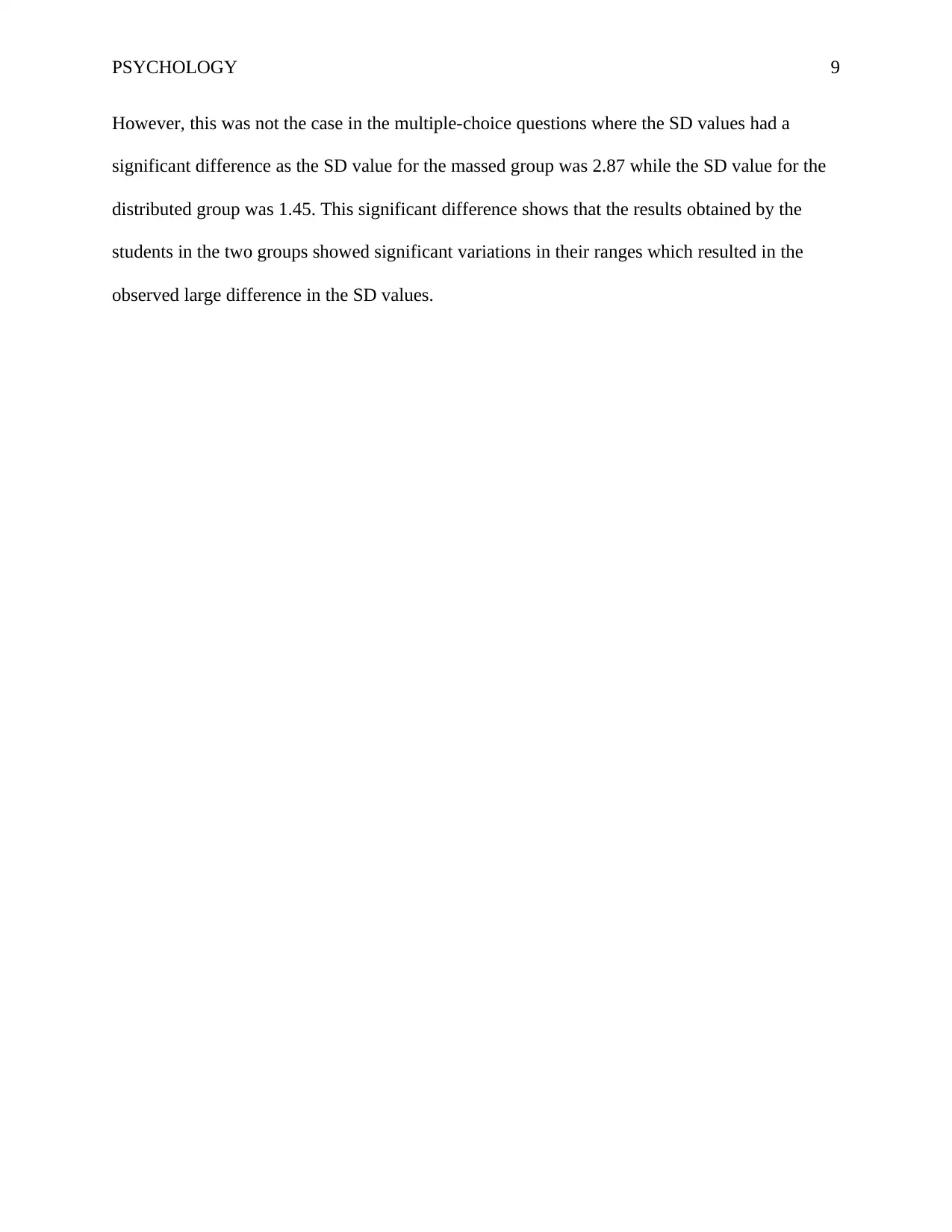
PSYCHOLOGY 9
However, this was not the case in the multiple-choice questions where the SD values had a
significant difference as the SD value for the massed group was 2.87 while the SD value for the
distributed group was 1.45. This significant difference shows that the results obtained by the
students in the two groups showed significant variations in their ranges which resulted in the
observed large difference in the SD values.
However, this was not the case in the multiple-choice questions where the SD values had a
significant difference as the SD value for the massed group was 2.87 while the SD value for the
distributed group was 1.45. This significant difference shows that the results obtained by the
students in the two groups showed significant variations in their ranges which resulted in the
observed large difference in the SD values.
⊘ This is a preview!⊘
Do you want full access?
Subscribe today to unlock all pages.

Trusted by 1+ million students worldwide
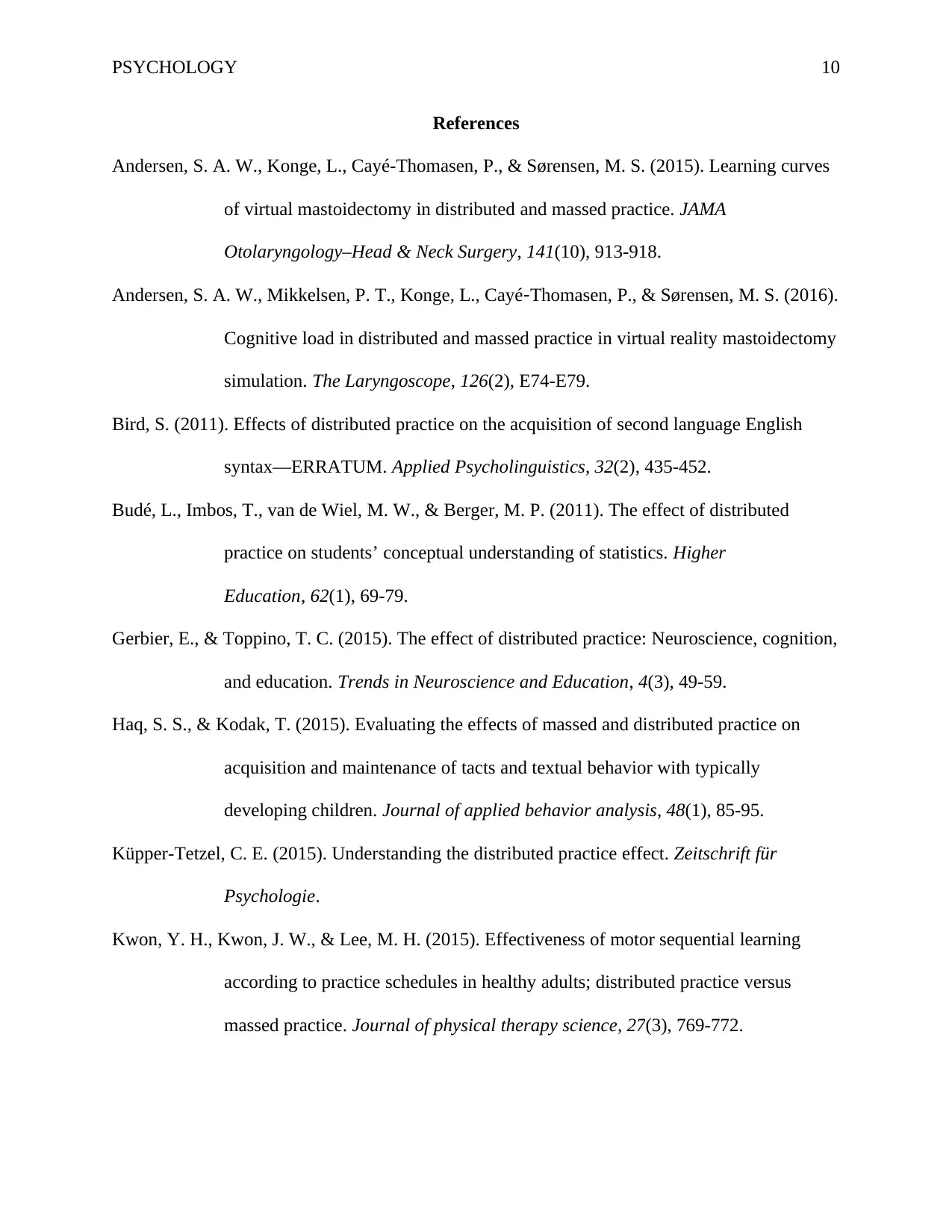
PSYCHOLOGY 10
References
Andersen, S. A. W., Konge, L., Cayé-Thomasen, P., & Sørensen, M. S. (2015). Learning curves
of virtual mastoidectomy in distributed and massed practice. JAMA
Otolaryngology–Head & Neck Surgery, 141(10), 913-918.
Andersen, S. A. W., Mikkelsen, P. T., Konge, L., Cayé‐Thomasen, P., & Sørensen, M. S. (2016).
Cognitive load in distributed and massed practice in virtual reality mastoidectomy
simulation. The Laryngoscope, 126(2), E74-E79.
Bird, S. (2011). Effects of distributed practice on the acquisition of second language English
syntax—ERRATUM. Applied Psycholinguistics, 32(2), 435-452.
Budé, L., Imbos, T., van de Wiel, M. W., & Berger, M. P. (2011). The effect of distributed
practice on students’ conceptual understanding of statistics. Higher
Education, 62(1), 69-79.
Gerbier, E., & Toppino, T. C. (2015). The effect of distributed practice: Neuroscience, cognition,
and education. Trends in Neuroscience and Education, 4(3), 49-59.
Haq, S. S., & Kodak, T. (2015). Evaluating the effects of massed and distributed practice on
acquisition and maintenance of tacts and textual behavior with typically
developing children. Journal of applied behavior analysis, 48(1), 85-95.
Küpper-Tetzel, C. E. (2015). Understanding the distributed practice effect. Zeitschrift für
Psychologie.
Kwon, Y. H., Kwon, J. W., & Lee, M. H. (2015). Effectiveness of motor sequential learning
according to practice schedules in healthy adults; distributed practice versus
massed practice. Journal of physical therapy science, 27(3), 769-772.
References
Andersen, S. A. W., Konge, L., Cayé-Thomasen, P., & Sørensen, M. S. (2015). Learning curves
of virtual mastoidectomy in distributed and massed practice. JAMA
Otolaryngology–Head & Neck Surgery, 141(10), 913-918.
Andersen, S. A. W., Mikkelsen, P. T., Konge, L., Cayé‐Thomasen, P., & Sørensen, M. S. (2016).
Cognitive load in distributed and massed practice in virtual reality mastoidectomy
simulation. The Laryngoscope, 126(2), E74-E79.
Bird, S. (2011). Effects of distributed practice on the acquisition of second language English
syntax—ERRATUM. Applied Psycholinguistics, 32(2), 435-452.
Budé, L., Imbos, T., van de Wiel, M. W., & Berger, M. P. (2011). The effect of distributed
practice on students’ conceptual understanding of statistics. Higher
Education, 62(1), 69-79.
Gerbier, E., & Toppino, T. C. (2015). The effect of distributed practice: Neuroscience, cognition,
and education. Trends in Neuroscience and Education, 4(3), 49-59.
Haq, S. S., & Kodak, T. (2015). Evaluating the effects of massed and distributed practice on
acquisition and maintenance of tacts and textual behavior with typically
developing children. Journal of applied behavior analysis, 48(1), 85-95.
Küpper-Tetzel, C. E. (2015). Understanding the distributed practice effect. Zeitschrift für
Psychologie.
Kwon, Y. H., Kwon, J. W., & Lee, M. H. (2015). Effectiveness of motor sequential learning
according to practice schedules in healthy adults; distributed practice versus
massed practice. Journal of physical therapy science, 27(3), 769-772.
Paraphrase This Document
Need a fresh take? Get an instant paraphrase of this document with our AI Paraphraser
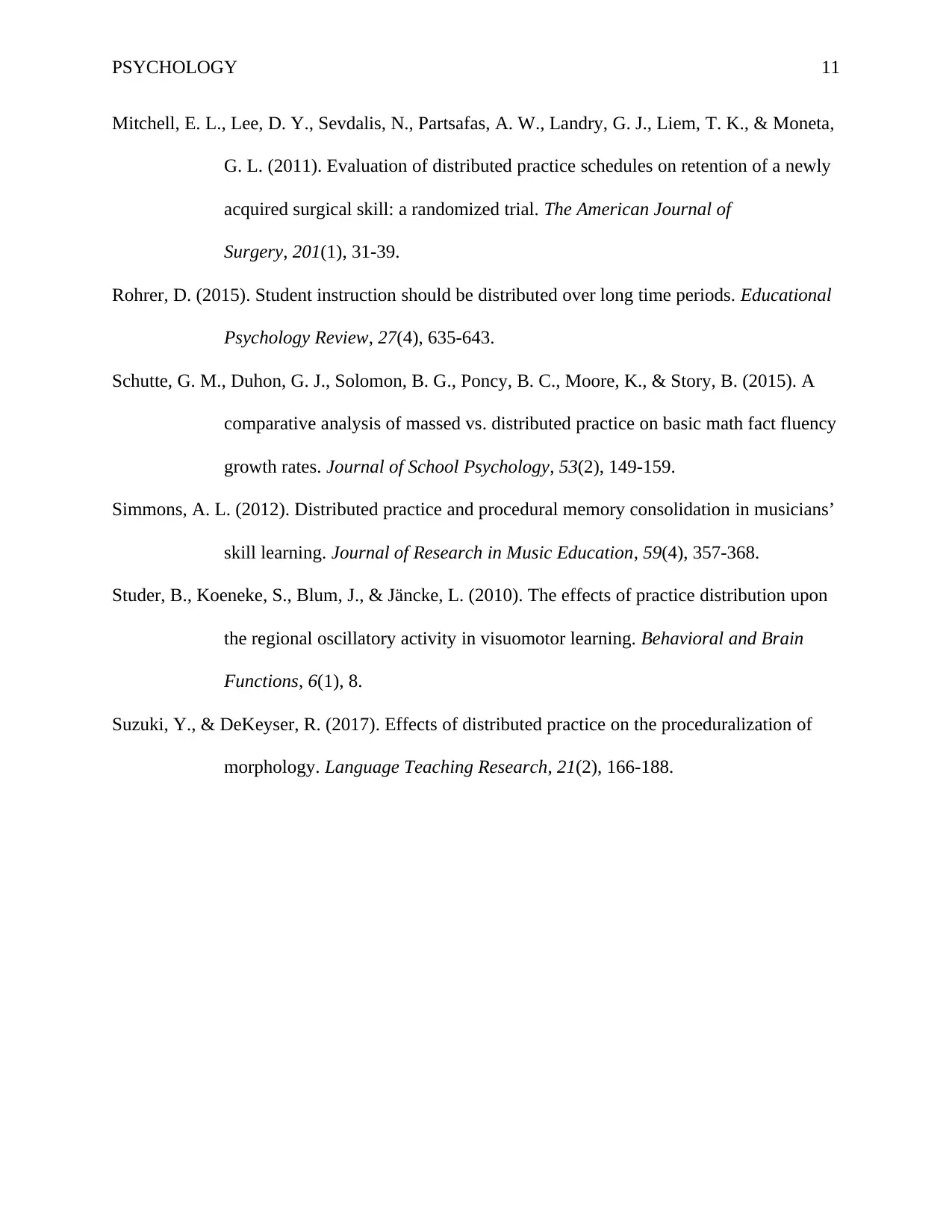
PSYCHOLOGY 11
Mitchell, E. L., Lee, D. Y., Sevdalis, N., Partsafas, A. W., Landry, G. J., Liem, T. K., & Moneta,
G. L. (2011). Evaluation of distributed practice schedules on retention of a newly
acquired surgical skill: a randomized trial. The American Journal of
Surgery, 201(1), 31-39.
Rohrer, D. (2015). Student instruction should be distributed over long time periods. Educational
Psychology Review, 27(4), 635-643.
Schutte, G. M., Duhon, G. J., Solomon, B. G., Poncy, B. C., Moore, K., & Story, B. (2015). A
comparative analysis of massed vs. distributed practice on basic math fact fluency
growth rates. Journal of School Psychology, 53(2), 149-159.
Simmons, A. L. (2012). Distributed practice and procedural memory consolidation in musicians’
skill learning. Journal of Research in Music Education, 59(4), 357-368.
Studer, B., Koeneke, S., Blum, J., & Jäncke, L. (2010). The effects of practice distribution upon
the regional oscillatory activity in visuomotor learning. Behavioral and Brain
Functions, 6(1), 8.
Suzuki, Y., & DeKeyser, R. (2017). Effects of distributed practice on the proceduralization of
morphology. Language Teaching Research, 21(2), 166-188.
Mitchell, E. L., Lee, D. Y., Sevdalis, N., Partsafas, A. W., Landry, G. J., Liem, T. K., & Moneta,
G. L. (2011). Evaluation of distributed practice schedules on retention of a newly
acquired surgical skill: a randomized trial. The American Journal of
Surgery, 201(1), 31-39.
Rohrer, D. (2015). Student instruction should be distributed over long time periods. Educational
Psychology Review, 27(4), 635-643.
Schutte, G. M., Duhon, G. J., Solomon, B. G., Poncy, B. C., Moore, K., & Story, B. (2015). A
comparative analysis of massed vs. distributed practice on basic math fact fluency
growth rates. Journal of School Psychology, 53(2), 149-159.
Simmons, A. L. (2012). Distributed practice and procedural memory consolidation in musicians’
skill learning. Journal of Research in Music Education, 59(4), 357-368.
Studer, B., Koeneke, S., Blum, J., & Jäncke, L. (2010). The effects of practice distribution upon
the regional oscillatory activity in visuomotor learning. Behavioral and Brain
Functions, 6(1), 8.
Suzuki, Y., & DeKeyser, R. (2017). Effects of distributed practice on the proceduralization of
morphology. Language Teaching Research, 21(2), 166-188.
1 out of 11
Related Documents
Your All-in-One AI-Powered Toolkit for Academic Success.
+13062052269
info@desklib.com
Available 24*7 on WhatsApp / Email
![[object Object]](/_next/static/media/star-bottom.7253800d.svg)
Unlock your academic potential
Copyright © 2020–2025 A2Z Services. All Rights Reserved. Developed and managed by ZUCOL.





